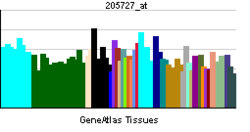TEP1
| Telomerase-associated protein 1 | |||||||||||||
|---|---|---|---|---|---|---|---|---|---|---|---|---|---|
| Identifiers | |||||||||||||
| Symbols | TEP1 ; TLP1; TP1; TROVE1; VAULT2; p240 | ||||||||||||
| External IDs | OMIM: 601686 MGI: 109573 HomoloGene: 5157 GeneCards: TEP1 Gene | ||||||||||||
| |||||||||||||
| RNA expression pattern | |||||||||||||
 | |||||||||||||
| More reference expression data | |||||||||||||
| Orthologs | |||||||||||||
| Species | Human | Mouse | |||||||||||
| Entrez | 7011 | 21745 | |||||||||||
| Ensembl | ENSG00000129566 | ENSMUSG00000006281 | |||||||||||
| UniProt | Q99973 | P97499 | |||||||||||
| RefSeq (mRNA) | NM_007110 | NM_009351 | |||||||||||
| RefSeq (protein) | NP_009041 | NP_033377 | |||||||||||
| Location (UCSC) | Chr 14: 20.83 – 20.88 Mb | Chr 14: 50.82 – 50.87 Mb | |||||||||||
| PubMed search | |||||||||||||
Telomerase protein component 1 is an enzyme that in humans is encoded by the TEP1 gene.[1][2]
This gene product is a component of the ribonucleoprotein complex responsible for telomerase activity which catalyzes the addition of new telomeres on the chromosome ends. The telomerase-associated proteins are conserved from ciliates to humans.[2] It is also a minor vault protein.
References
- ↑ Saito T, Matsuda Y, Suzuki T, Hayashi A, Yuan X, Saito M, Nakayama J, Hori T, Ishikawa F (Jan 1998). "Comparative gene mapping of the human and mouse TEP1 genes, which encode one protein component of telomerases". Genomics 46 (1): 46–50. doi:10.1006/geno.1997.5005. PMID 9403057.
- ↑ 2.0 2.1 "Entrez Gene: TEP1 telomerase-associated protein 1".
Further reading
- Joly EC; Tremblay E; Tanguay RM et al. (1995). "TRiC-P5, a novel TCP1-related protein, is localized in the cytoplasm and in the nuclear matrix". J. Cell. Sci. 107 (10): 2851–9. PMID 7876352.
- Harrington L; McPhail T; Mar V et al. (1997). "A mammalian telomerase-associated protein". Science 275 (5302): 973–7. doi:10.1126/science.275.5302.973. PMID 9020079.
- Harrington L; Zhou W; McPhail T et al. (1998). "Human telomerase contains evolutionarily conserved catalytic and structural subunits". Genes Dev. 11 (23): 3109–15. doi:10.1101/gad.11.23.3109. PMC 316744. PMID 9389643.
- Li H; Zhao L; Yang Z et al. (1999). "Telomerase is controlled by protein kinase Calpha in human breast cancer cells". J. Biol. Chem. 273 (50): 33436–42. doi:10.1074/jbc.273.50.33436. PMID 9837921.
- Kickhoefer VA; Stephen AG; Harrington L et al. (2000). "Vaults and telomerase share a common subunit, TEP1". J. Biol. Chem. 274 (46): 32712–7. doi:10.1074/jbc.274.46.32712. PMID 10551828.
- Li H; Cao Y; Berndt MC et al. (2000). "Molecular interactions between telomerase and the tumor suppressor protein p53 in vitro". Oncogene 18 (48): 6785–94. doi:10.1038/sj.onc.1203061. PMID 10597287.
- Koyanagi Y; Kobayashi D; Yajima T et al. (2000). "Telomerase activity is down regulated via decreases in hTERT mRNA but not TEP1 mRNA or hTERC during the differentiation of leukemic cells". Anticancer Res. 20 (2A): 773–8. PMID 10810353.
- Beattie TL, Zhou W, Robinson MO, Harrington L (2000). "Polymerization Defects within Human Telomerase Are Distinct from Telomerase RNA and TEP1 Binding". Mol. Biol. Cell 11 (10): 3329–40. doi:10.1091/mbc.11.10.3329. PMC 14995. PMID 11029039.
- Zhang RG, Zhang RP, Wang XW, Xie H (2004). "Effects of cisplatin on telomerase activity and telomere length in BEL-7404 human hepatoma cells". Cell Res. 12 (1): 55–62. doi:10.1038/sj.cr.7290110. PMID 11942411.
- Chang JT; Chen YL; Yang HT et al. (2002). "Differential regulation of telomerase activity by six telomerase subunits". Eur. J. Biochem. 269 (14): 3442–50. doi:10.1046/j.1432-1033.2002.03025.x. PMID 12135483.
- Strausberg RL; Feingold EA; Grouse LH et al. (2003). "Generation and initial analysis of more than 15,000 full-length human and mouse cDNA sequences". Proc. Natl. Acad. Sci. U.S.A. 99 (26): 16899–903. doi:10.1073/pnas.242603899. PMC 139241. PMID 12477932.
- Zhou JH; Zhang HM; Chen Q et al. (2003). "Relationship between telomerase activity and its subunit expression and inhibitory effect of antisense hTR on pancreatic carcinoma". World J. Gastroenterol. 9 (8): 1808–14. PMID 12918126.
- Li C, Wu MY, Liang YR, Wu XY (2003). "Correlation between expression of human telomerase subunits and telomerase activity in esophageal squamous cell carcinoma". World J. Gastroenterol. 9 (11): 2395–9. PMID 14606063.
- Lim J; Hao T; Shaw C et al. (2006). "A protein-protein interaction network for human inherited ataxias and disorders of Purkinje cell degeneration". Cell 125 (4): 801–14. doi:10.1016/j.cell.2006.03.032. PMID 16713569.